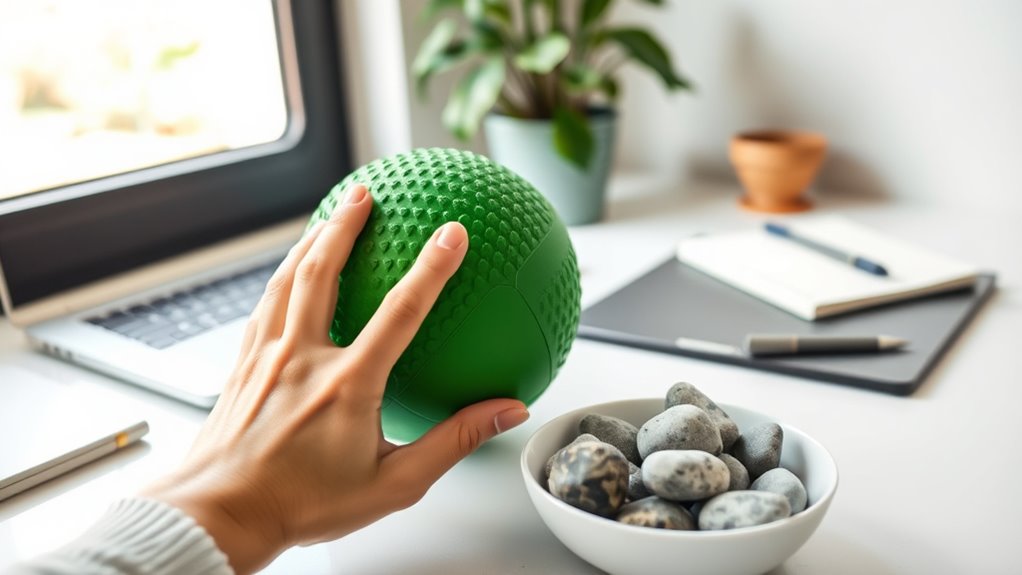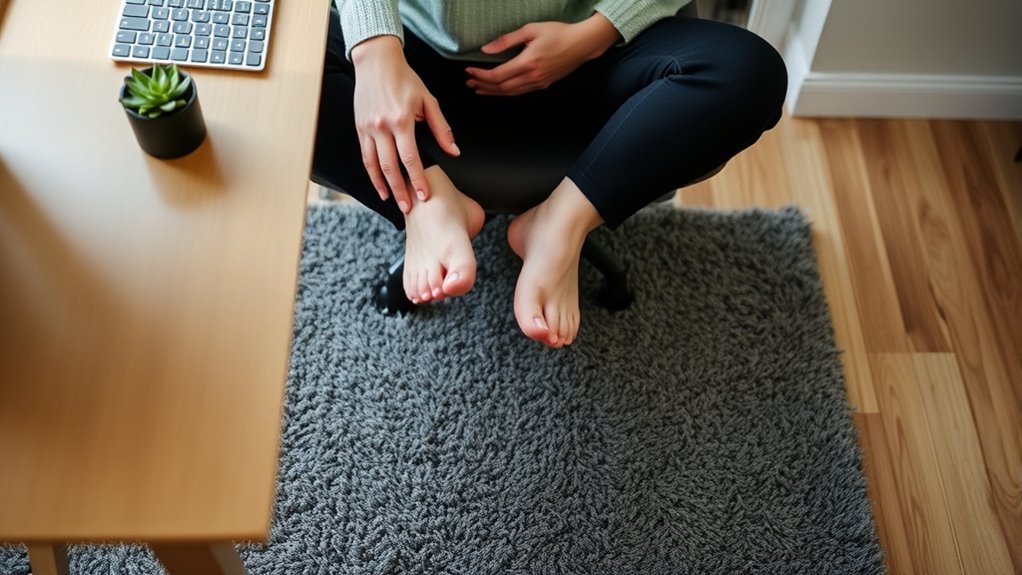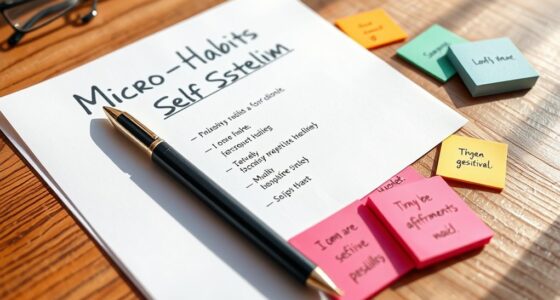When stress hits at your desk, grounding techniques can help you regain focus quickly. Try noticing five things around you, feeling their textures, or listening for three sounds. You can also do a quick body scan from toes to head or hold a small object like a stress ball to redirect your attention. Incorporating these simple actions during busy moments can boost your calm and resilience—stay with us to explore even more effective methods.
Key Takeaways
- Use sensory awareness by noticing five things visible around your desk.
- Hold a small tactile object, like a stress ball or textured pen, to focus on its feel.
- Take deep breaths, paying attention to the sensation of air filling and leaving your lungs.
- Conduct a quick body scan from toes to head, noticing tension without judgment.
- Set periodic reminders to pause, breathe deeply, or perform quick grounding exercises during the day.

When stress or anxiety strike during a busy workday, grounding techniques can help you regain focus and calm your mind. One effective way is through mindfulness exercises. These practices encourage you to pay close attention to your present moment experiences, which can considerably reduce anxiety. For example, you might take a few deep breaths, focusing solely on the sensation of air filling your lungs and then releasing it slowly. This simple act helps anchor your attention away from racing thoughts or worries about deadlines. Alternatively, you can do a quick body scan, starting from your toes and moving upward, noticing any tension or discomfort without judgment. By intentionally observing your physical sensations, you create a mental pause that eases your mind from anxiety-provoking thoughts.
Mindfulness exercises are especially useful during stressful moments because they shift your focus inward, helping you regain control over your reactions. When you feel overwhelmed, try grounding yourself by noticing five things you can see, four you can touch, three you can hear, two you can smell, and one you can taste. This sensory awareness anchors you in the present and effectively reduces anxiety. It’s a straightforward method you can do at your desk without needing special equipment. The more you practice these mindfulness techniques, the quicker you’ll be able to access a sense of calm during tense moments.
Use your senses to ground yourself and reduce anxiety during stressful moments at work.
Another helpful approach is to engage your senses intentionally to bring your attention to the here and now. You might hold a small object, like a stress ball or a textured pen, and focus on its feel, weight, and temperature. This tactile grounding method helps divert your mind from anxious thoughts. You can also set a timer to remind yourself to pause and take a few deep breaths periodically throughout the day. Consistently practicing these mindfulness exercises creates a mental toolkit that promotes anxiety reduction, helping you stay centered amid a hectic schedule. Incorporating grounding techniques into your routine can also serve as a preventative measure to manage daily stress more effectively.
Incorporating these grounding techniques into your daily routine isn’t complicated, but it requires consistency. Even a few minutes of mindful awareness, breathing exercises, or sensory focus can make a notable difference in how you handle stress. Over time, you’ll notice a greater ability to stay present, manage anxiety more effectively, and improve your overall resilience during busy workdays. Remember, the goal of these mindfulness exercises is not only to reduce immediate anxiety but also to build a foundation of calm that you can carry with you through all your daily challenges.
Frequently Asked Questions
Can Grounding Techniques Replace Professional Mental Health Treatment?
Grounding techniques can help manage stress temporarily, but they aren’t a substitute for professional support. While grounding has limitations, such as not addressing underlying mental health issues, it can be a helpful complement between therapy sessions. You shouldn’t rely solely on these techniques for ongoing mental health treatment. Instead, consider them as part of a broader approach that includes professional guidance to guarantee thorough care and support.
How Long Should I Practice Each Grounding Technique?
You should practice each grounding technique for about 1 to 3 minutes, focusing on timing consistency to build a routine. Try different techniques to find what works best for you, maintaining variety to keep your practice effective. Use grounding exercises whenever you feel overwhelmed or anxious, and remember, regular practice helps reinforce calmness. Adjust the duration based on your comfort level, but consistency is key to experiencing the benefits.
Are Grounding Exercises Effective During High-Stress Moments?
Ever wonder if grounding exercises work during high-stress moments? The answer is yes, they can provide immediate relief and stress reduction when you need it most. These quick techniques anchor you in the present, disrupting overwhelming thoughts. By focusing on your breath or sensations, you regain control and calm your mind, making them effective tools to manage intense emotions right when you need them.
Can Children or Elderly Persons Easily Perform These Techniques?
You might wonder if children or elderly persons can easily perform grounding techniques. The answer is yes, with child-friendly methods and elderly adaptations, these techniques become accessible. You can simplify exercises, such as focusing on breathing or using sensory objects. These adjustments help both groups stay engaged and benefit from grounding, making stress management manageable regardless of age. Your awareness guarantees everyone can find calming strategies suited to their needs.
What Are Signs That I Need More Than Just Grounding Techniques?
When you notice emotional overwhelm or persistent anxiety, it’s a sign you might require more support. If grounding techniques no longer ease your feelings, if your symptoms interfere with daily life, or if you feel hopeless or overwhelmed despite your efforts, it’s time to seek professional help. Recognizing these signs ensures you get the appropriate guidance and care needed to manage your mental health effectively.
Conclusion
By trying these grounding techniques at your desk, you’ll find it easier to stay present and calm amidst the chaos—no need for a crystal ball or a magic wand. Remember, even in this fast-paced world, you can pause and reconnect, just like a knight taking a breather before facing the next quest. So, take a moment, breathe deeply, and reclaim your peace. After all, your well-being is the true treasure in any modern-day adventure.










